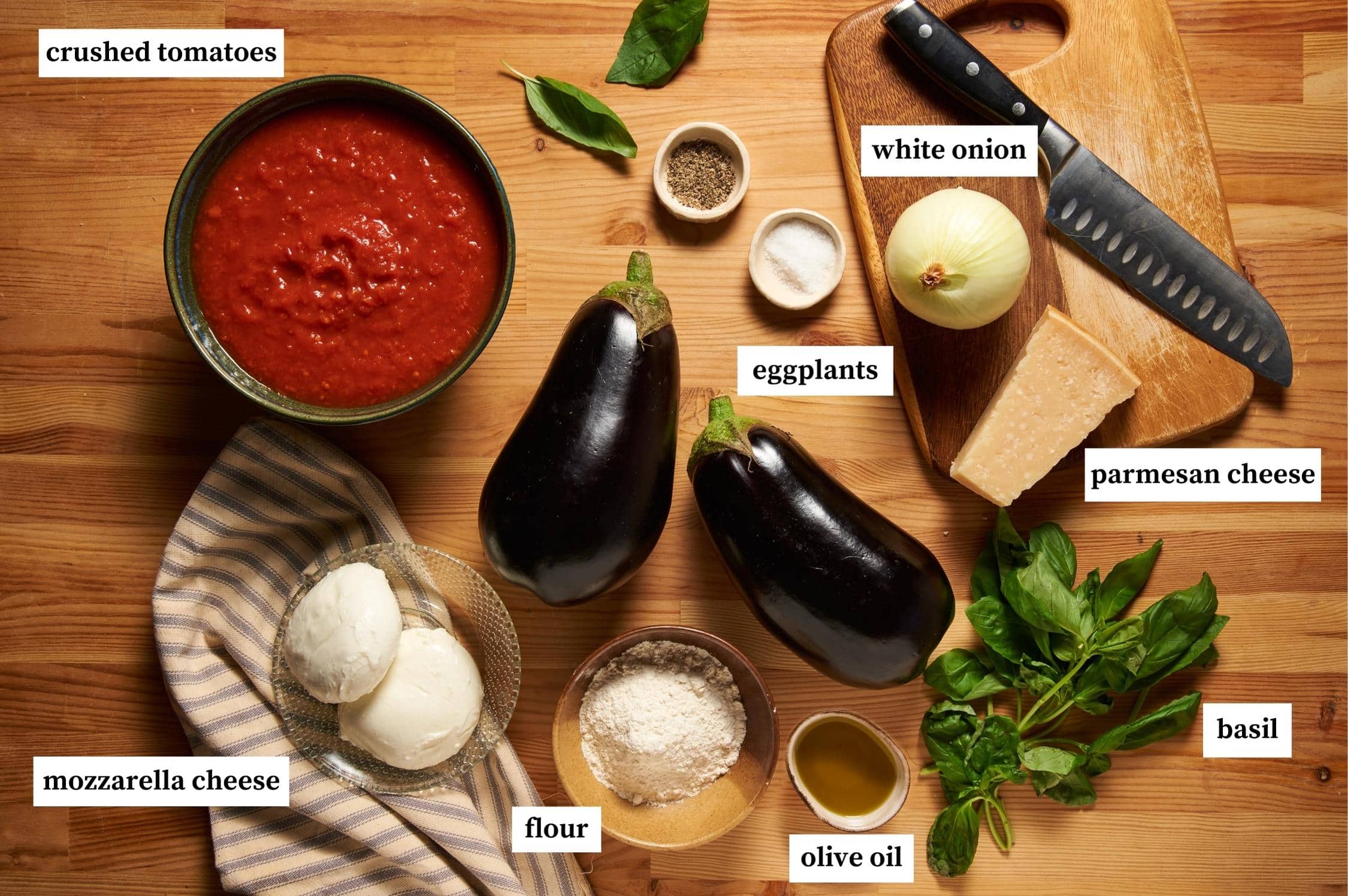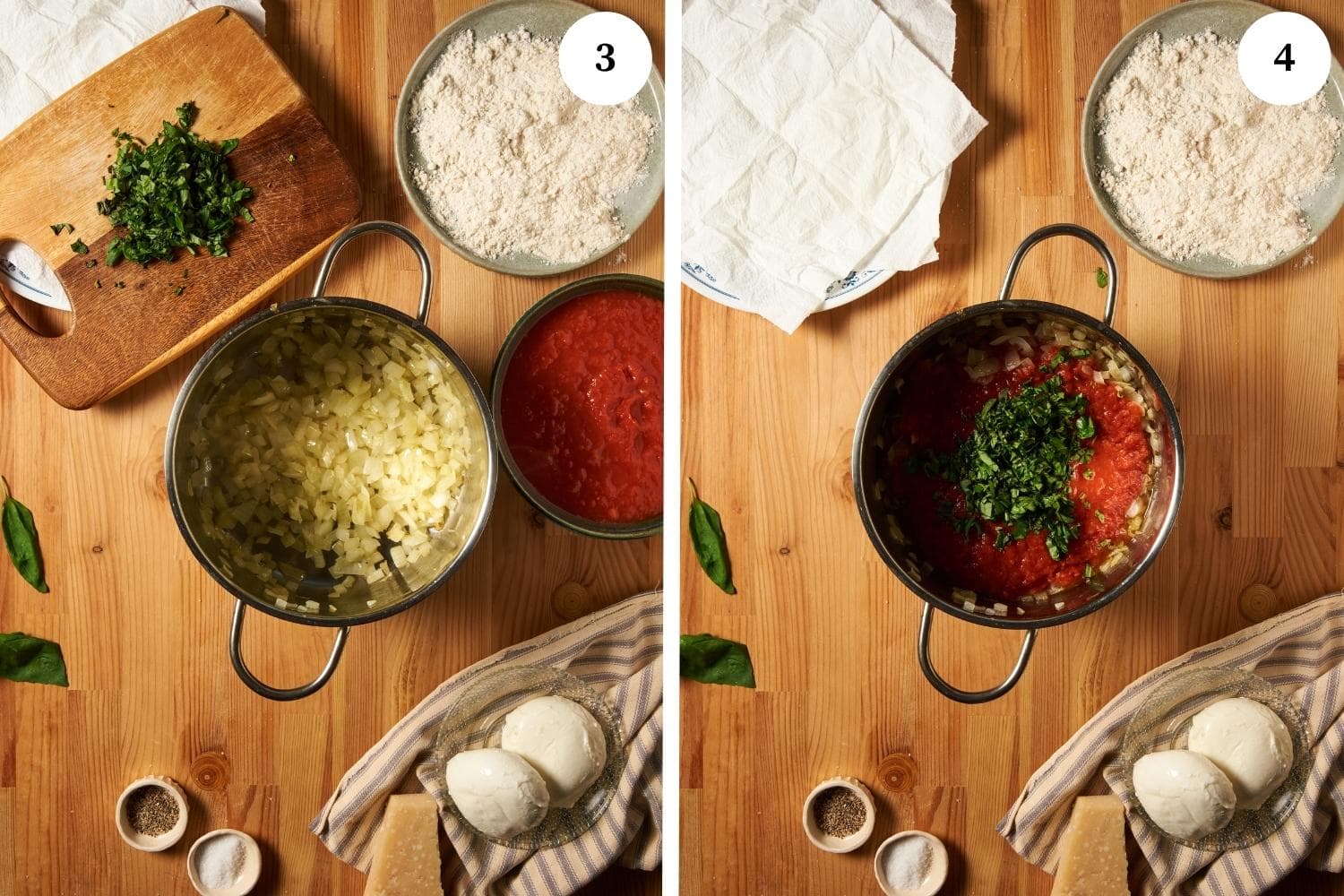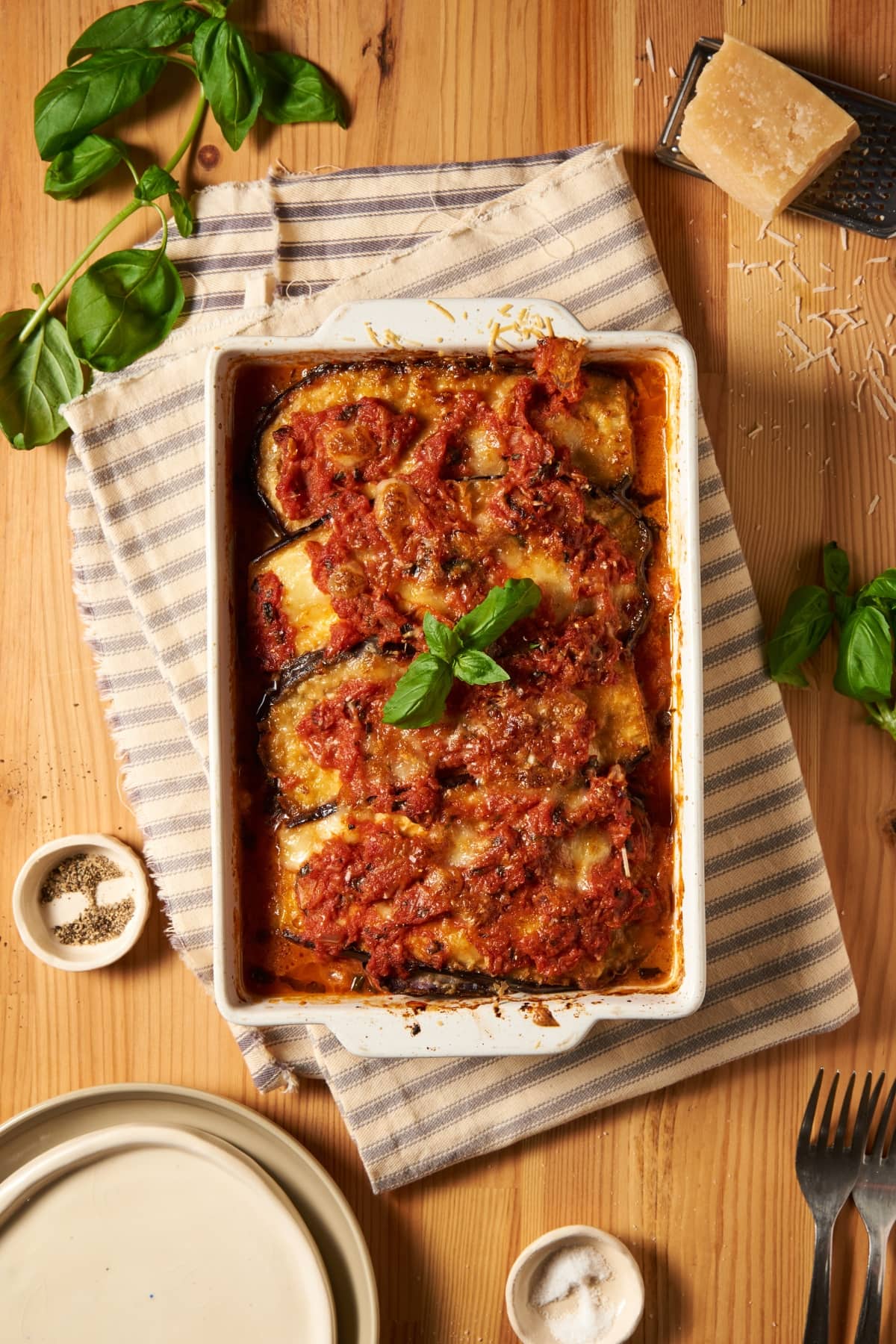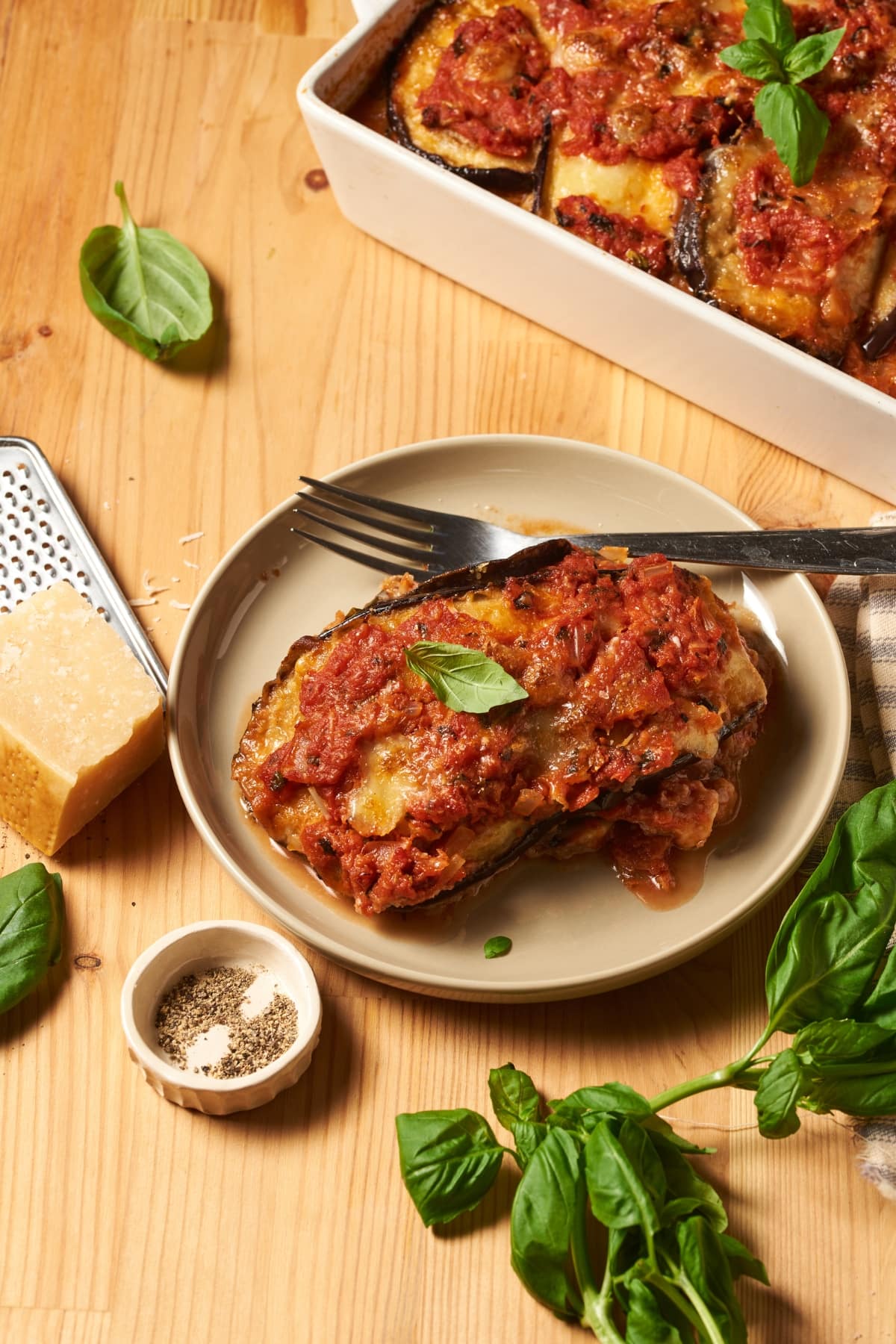Perfectly cooked tender slices of eggplant are layered between lots of melted cheese and a delicious basil infused homemade marinara sauce to make this incredible Eggplant Parmigiana! It’s a classic Italian comfort food bursting with flavor. This recipe will show you how easy it is to make and includes instructions on how to fry, bake, or grill the eggplant!

Also known as parmigiana di melanzane in Italy and eggplant parmesan in the United States, it’s basically an Italian eggplant casserole. Traditionally made with thick slices of fried eggplant, it’s also possible to bake or grill the eggplant as well. It’s a vegetarian dish is made similar to lasagna by assembling layers of Italian cheese and red sauce. However, in this case, eggplant slices are used in place of sheets of pasta. Then it’s topped with one final layer of grated cheese and popped into the oven to bake. Then about 40 minutes later the eggplant parmesan comes out of the oven bubbling with a lovely cheesy gratin-like crust.

To begin, you don’t need to peel the eggplant skin but it is a good idea to draw out the moisture before cooking it. To do this, first cut the eggplant into thick ½-inch slices. Then sprinkle them on both sides with salt and put them in a colander in the sink. Now, leave the eggplant to sit for 1 hour so that the salt has time to draw out the excess water. This step helps to prevent the eggplant from having a soggy texture.

While the eggplant is resting in the colander you can make the tomato sauce. First, heat 1 tablespoon of olive oil over medium heat in a medium saucepan. Next, add the chopped onion and cook it until it’s soft and translucent. Then add the crushed tomatoes along with the chopped basil and bring the sauce to a simmer. Now, let it cook for 20 minutes, stirring from time to time. Then when the sauce is done, taste it and season it with salt and pepper as needed. Now, remove the sauce from the heat and set it aside.

Right before you start frying your eggplant, preheat the oven to 350°F (180°C) so that it’s ready to go! Then line a plate with paper towels to drain your fried eggplant.
Before you can fry the eggplant you’ll need to wash the salt off of all the slices and then pat them dry with paper towels. Then dredge the eggplant in flour on both sides making sure to shake off the excess.

After the eggplant is coated in flour, heat the remaining ¼ cup of olive oil over medium-high heat in a frying pan. Then when the oil is hot add the sliced eggplant to the pan in a single layer and fry it on each side for about 30 seconds or until it’s slightly browned. Now, transfer the fried eggplant to the plate lined with paper towels. You will most likely need to fry the eggplant in batches.

Once the eggplant is cooked you can start building the casserole. To begin, evenly cover the bottom of the 9×13-inch baking dish with some of the sauce. Then put a single layer of eggplant slices on top of the sauce.

Next, sprinkle the eggplant with ⅓ of the grated parmesan cheese and ⅓ of the cubed mozzarella. Then top the cheese with a few spoonfuls of the tomato sauce. Now, repeat the process with another layer of eggplant, ⅓ of the parmesan cheese, ⅓ of the mozzarella cheese, and tomato sauce.

Finally, spread the remaining tomato sauce over the top and sprinkle with the rest of the grated parmesan and mozzarella cheese.

After the casserole is assembled, cover the baking dish loosely with foil. Then transfer it to the preheated oven and bake it for 20 minutes. Now, remove the foil and bake the eggplant for another 20 minutes or until it’s golden brown on top and bubbling. Then when it’s done, allow the eggplant parmesan to sit for 5 minutes before serving.

Eggplant Parmigiana is a popular Italian dish with variations in ingredients between regions. This Italian recipe, also known as parmigiana di melanzane, is the most well recognized. However, in Sicily Caciocavallo cheese is used instead of mozzarella. And in Campania, you will find variations that include ham or hard-boiled eggs.
Not to mention, how the eggplant is cooked can vary as well. It does not have to be fried. You can bake the eggplant or grill it instead. Just follow these instructions once you rinse the salt off of the eggplant and pat it dry.
To bake: Preheat the oven to 400°F (204°C). Then place the sliced eggplant in a single layer on a baking sheet. Next, drizzle it with olive oil and put it into the oven to bake for 15 minutes. Now, flip the slices over and bake them for another 10 to 15 minutes until the baked eggplant is soft and golden.
To grill: Preheat the grill to a medium-high heat. Then brush both sides of the eggplant with olive oil. Now, grill the eggplant uncovered for about 4 minutes. Then flip it over and grill the other side for about 3 minutes. When it’s done it should be slightly charred but not burnt.
Yes! And freezing it is the best way to do it. To freeze the eggplant parmesan before baking, assemble the dish but don’t bake it. Then wrap it with plastic wrap and foil to freeze it for up to one month. Then when ready, thaw the dish out at room temperature and bake it. But to freeze the dish after baking, wrap it well in plastic wrap and put it in the freezer for up to a month. Then thaw it at room temperature and warm it in the oven at 350°F (180°C) for about 20 to 30 minutes.
Leftovers will keep for up to 5 days in the fridge when stored in an airtight container. Then to reheat, put the eggplant parmesan in the oven at 350°F (180°C) for about 10 to 15 minutes or in the microwave on medium power. The leftovers can also be stored in the freezer for up to 3 months. You can then reheat them in the oven from frozen for about 30 minutes. Keep in mind, how long it takes to reheat leftovers is also dependent on the amount you are reheating.
There is no need to peel the eggplant. In fact, it’s best if you don’t. The skin actually helps to maintain the shape of the eggplant as it cooks.
The terms tend to be used interchangeably in the US, but they are not exactly the same. Parmigiana typically refers to Parmigiano-Reggiano, which is a hard cheese made from cow’s milk that is aged at least 2 years. Whereas, parmesan cheese is also made from cow’s milk but normally only aged for 10 to 12 months.


Everyone agrees that eggplant arrived in Italy around the 9th century when the Arabs brought the vegetable to the southern part of the country. And we know that it dates back to the late 1300s when it’s mentioned in a poem about food. But like many Italian dishes, the origins of eggplant parmigiana are disputed. The dish most resembles the cooking style of Naples in southern Italy. But others say it’s from Sicily due to its name which references the Sicilian word “palmigiana” which means “shutters” like the overlapping layers of the dish. And there is even an argument that its origins are in Parma in Northern Italy, which is the home of parmesan cheese.
Yet, the dish that we know today as eggplant parmigiana was first seen in the cookbook Cucina Teorico-Pratica by Ippolito Cavalcanti, published in 1837. At the time the cookbook was very popular in Naples and the first time a recipe was seen for eggplant that was layered in tomato sauce. It quickly became one of Italy’s favorite eggplant recipes.